Abstract
1. In the guinea-pig, a unilateral labyrinthectomy induces postural disturbances and an ocular nystagmus which abate or disappear over time. These behavioural changes are accompanied by an initial collapse and a subsequent restoration of the spontaneous activity in the neurones of the ipsilateral vestibular nuclei. Recently, it has been shown that the vestibular neuronal activity remained collapsed over at least 10 h whereas its restoration was complete 1 week after the lesion. The aims of this study were to determine when restoration of spontaneous activity in the partially deafferented vestibular neurones started and to compare the time courses of the behavioural and neuronal recoveries in guinea-pigs that had undergone a unilateral labyrinthectomy. 2. Neuronal discharge measurements were made using chronic extracellular recording of single unit activity. After a left labyrinthectomy, electrodes, were placed on the site of the destroyed labyrinth to enable stimulation of the left vestibular nerve. Behavioural measurements included chronic recording of eye movements by the scleral search coli technique. After a left labyrinthectomy, lateral deviation of the head, twisting of the head, and eye velocity of the slow phases of the nystagmus were measured. 3. The neuronal activity of the rostral part of the vestibular nuclear complex on the lesioned side was recorded in alert guinea-pigs over 4 h recording sessions between 12 and 72 h after the lesion. 4. The criterion used to select vestibular neurones for analysis was their recruitment by an electric shock on the vestibular nerve. In addition, in order to explore a uniform population, we focused on neurones recruited at monosynaptic latencies (0.85-1.15 ms). 5. For each recording period, the mean resting rate was calculated animal by animal and the grand mean of these individual resting rate means was calculated. Previously, a decline in the grand mean resting rate from 35.8 +/- 6.0 spikes s-1 (control state) to 7.1 +/- 4.2 spikes s-1 during the first 4 h after labyrinthectomy has been shown. In the present study, the first sign of recovery was observed during the 12-16 h recording period when the resting rate grand mean increased to 16.3 +/- 3.9 spikes s-1. This grand mean activity did not change significantly during the following 12 h. Thereafter, restoration of neuronal activity improved and was complete 1 week after the lesion. 6. Although the abatement of the vestibular symptoms roughly paralleled the restoration of neuronal activity in the vestibular nuclei, some discrepancies between the time courses of both phenomena emerged. An important step in postural recovery (the animals managed to stand up) and a major part of the abatement of the nystagmus occurred before the recovery of vestibular neuronal activity. In addition, lateral deviation of the head disappeared while restoration of the neuronal activity was incomplete, but significant head twisting was still evident when vestibular resting rates had recovered completely. 7. We conclude that restoration of neuronal activity in the ipsilateral vestibular nuclei starts 12 h after the lesion and that restoration of neuronal activity in the ipsilateral vestibular nuclei is not the only mechanism underlying behavioural vestibular compensation.
Full text
PDF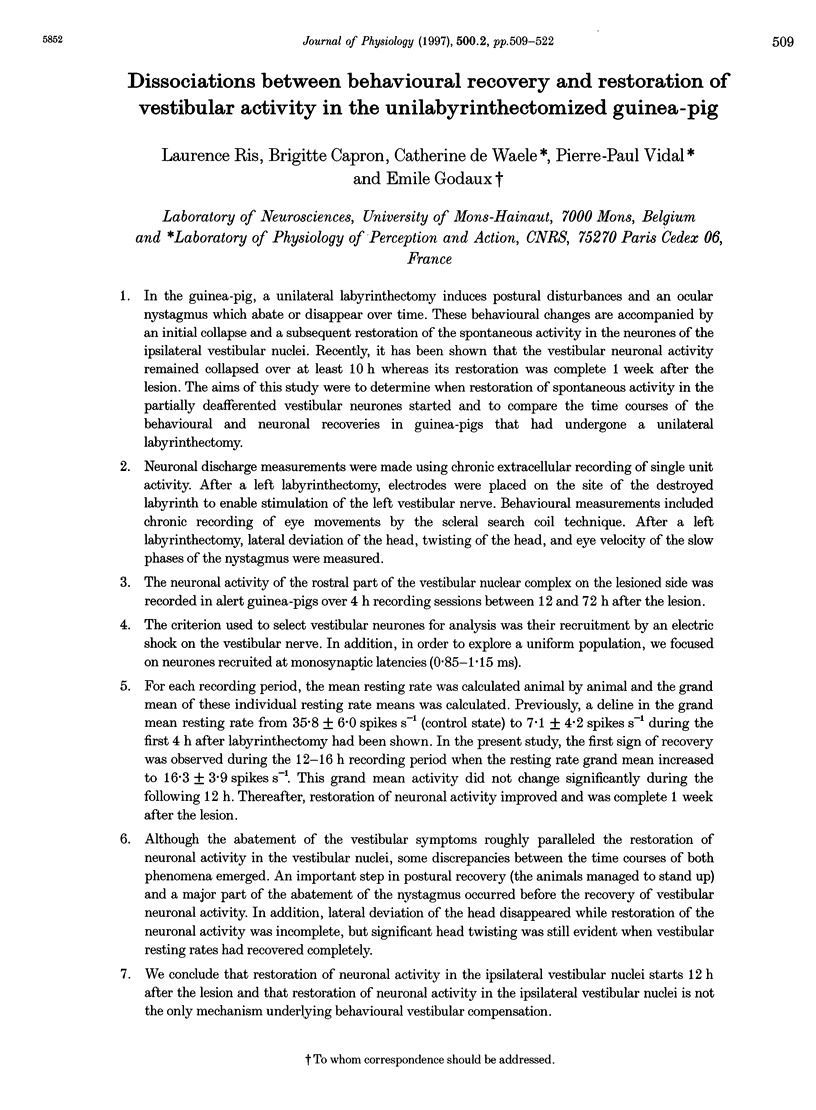

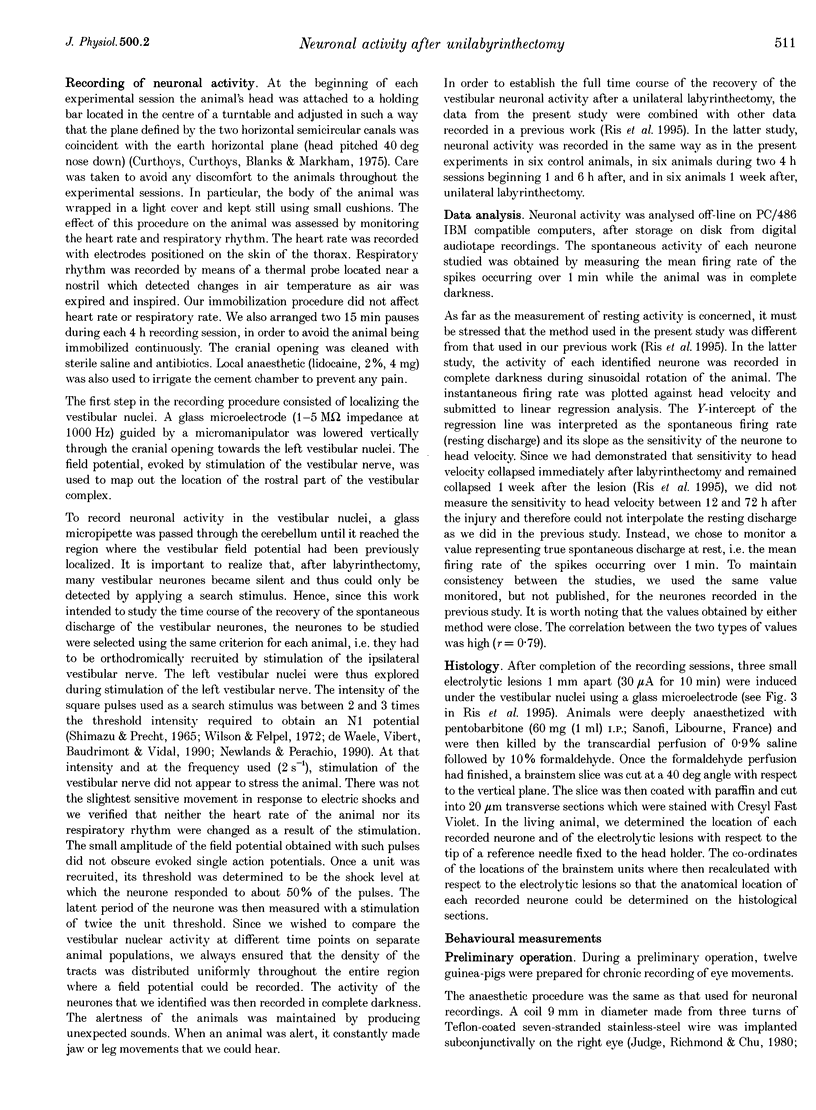

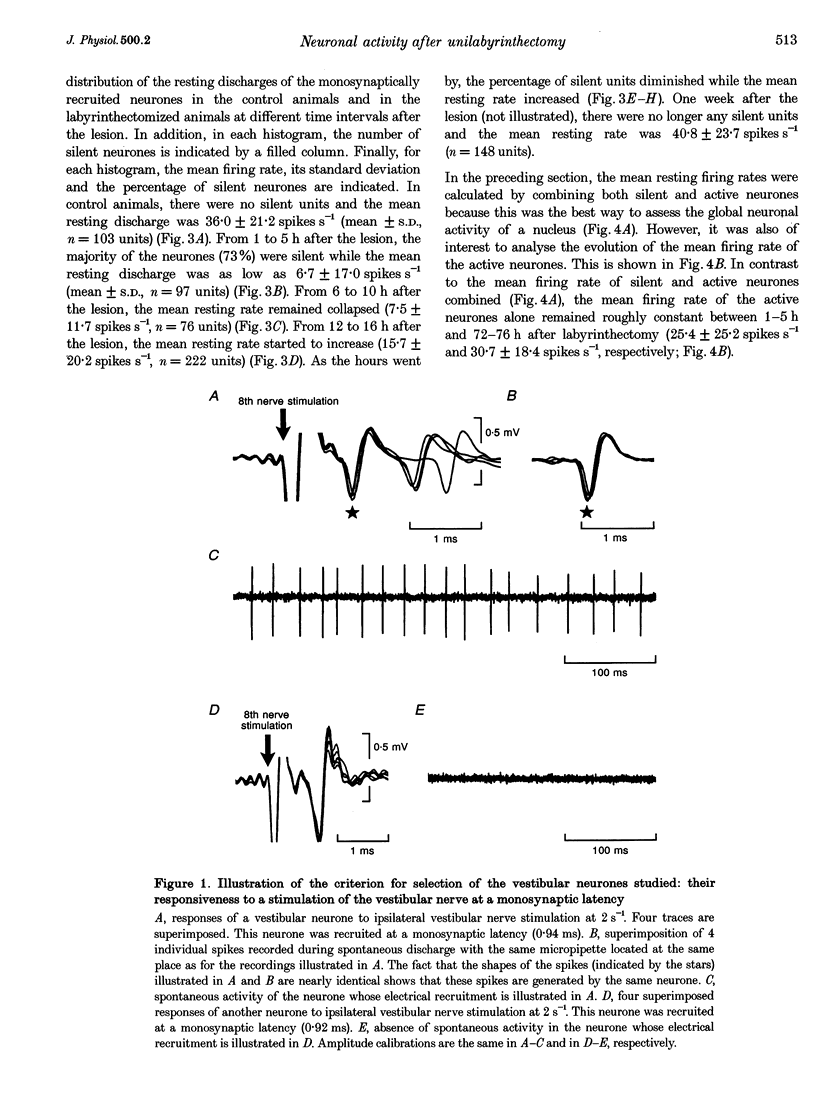

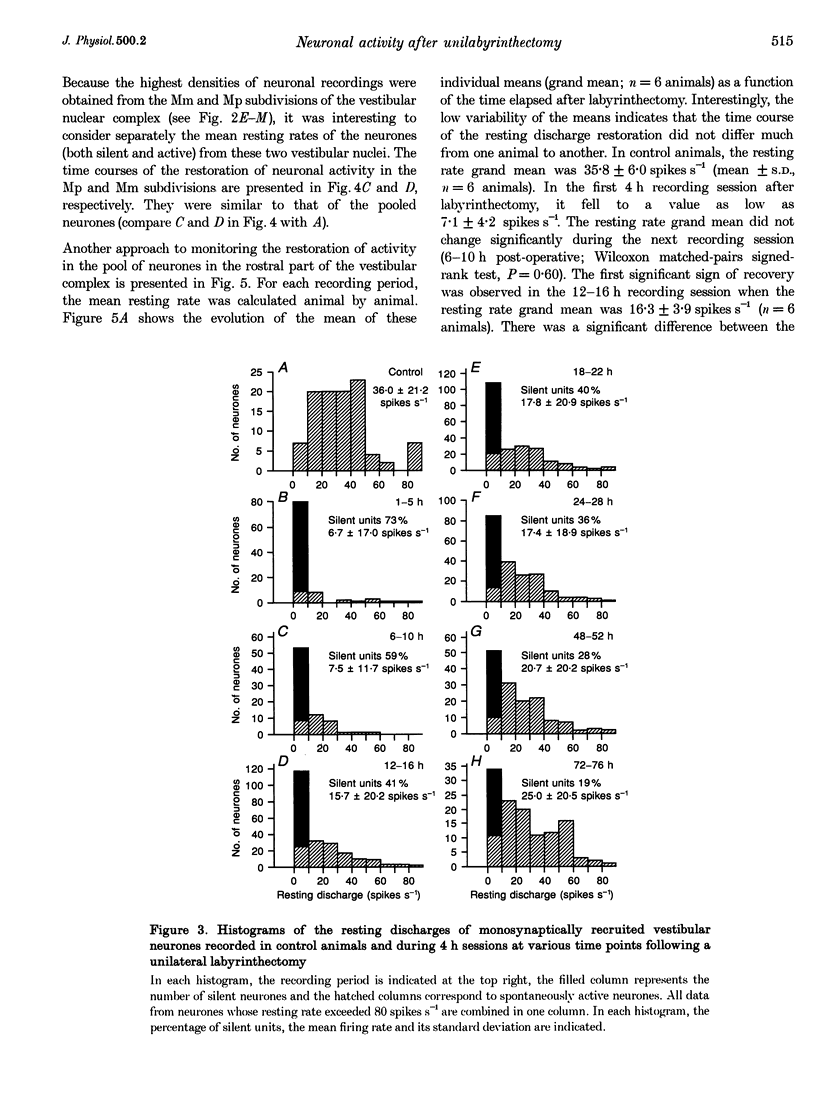
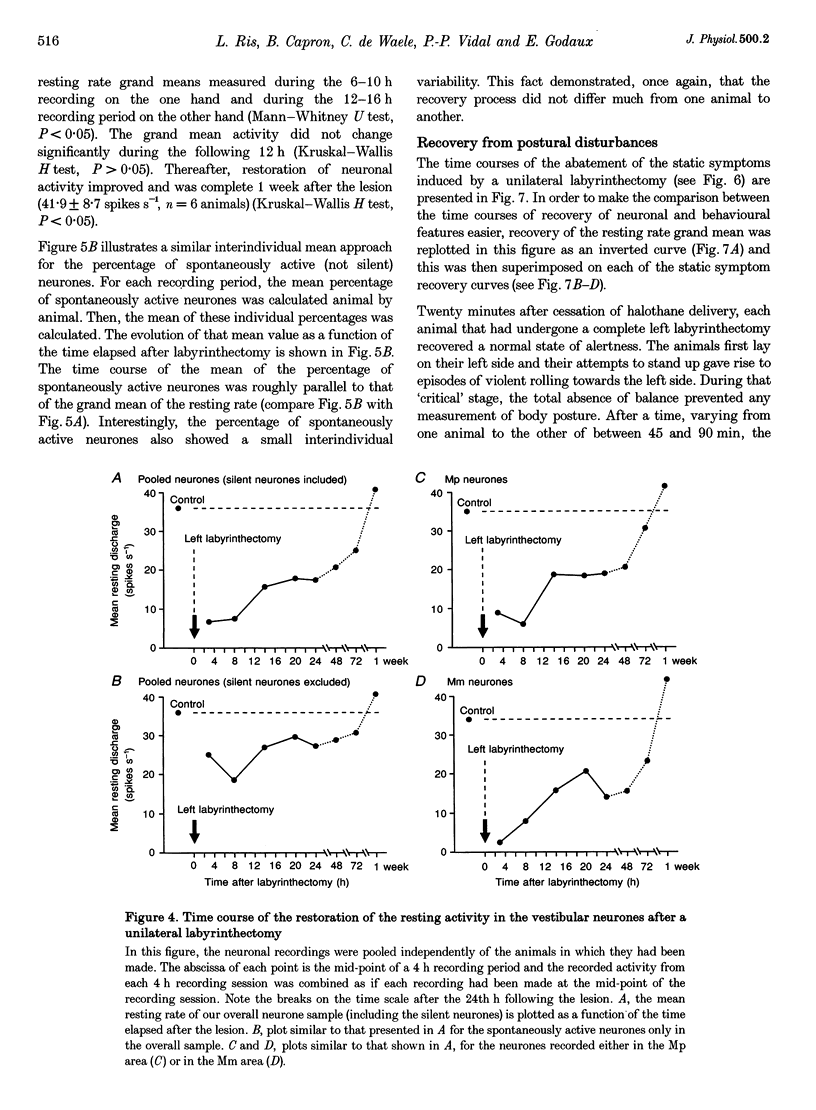
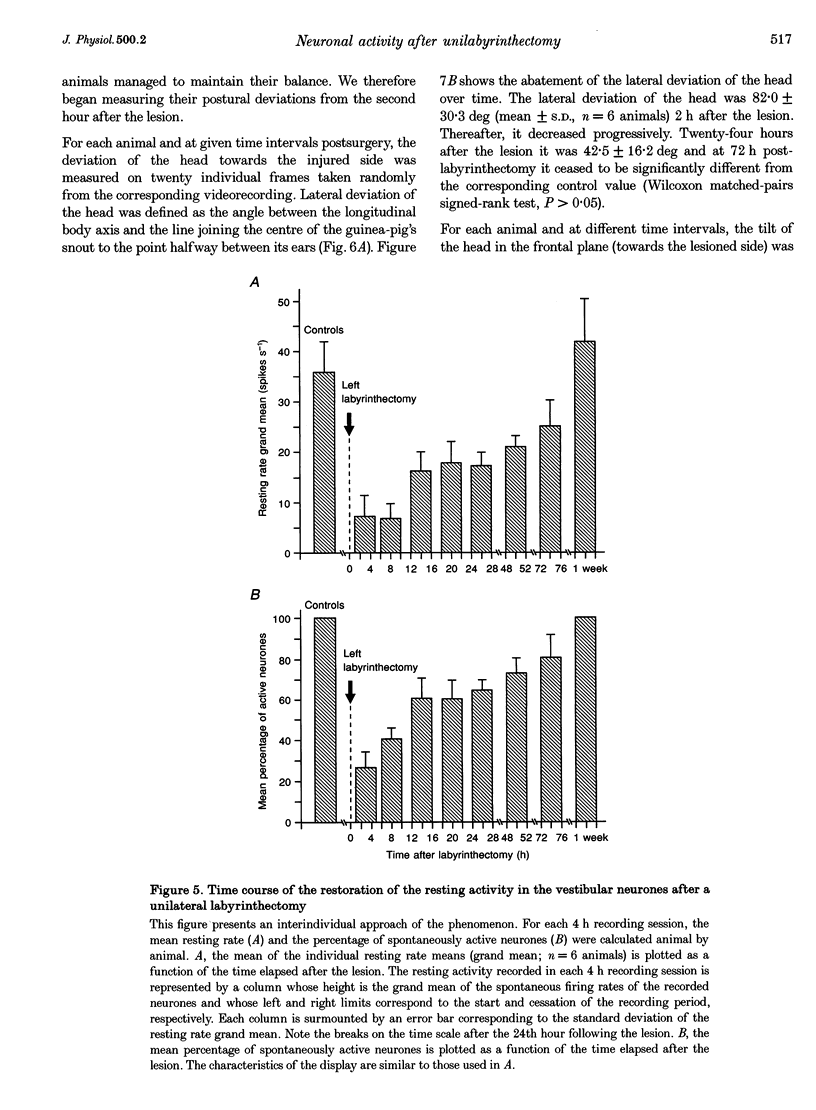
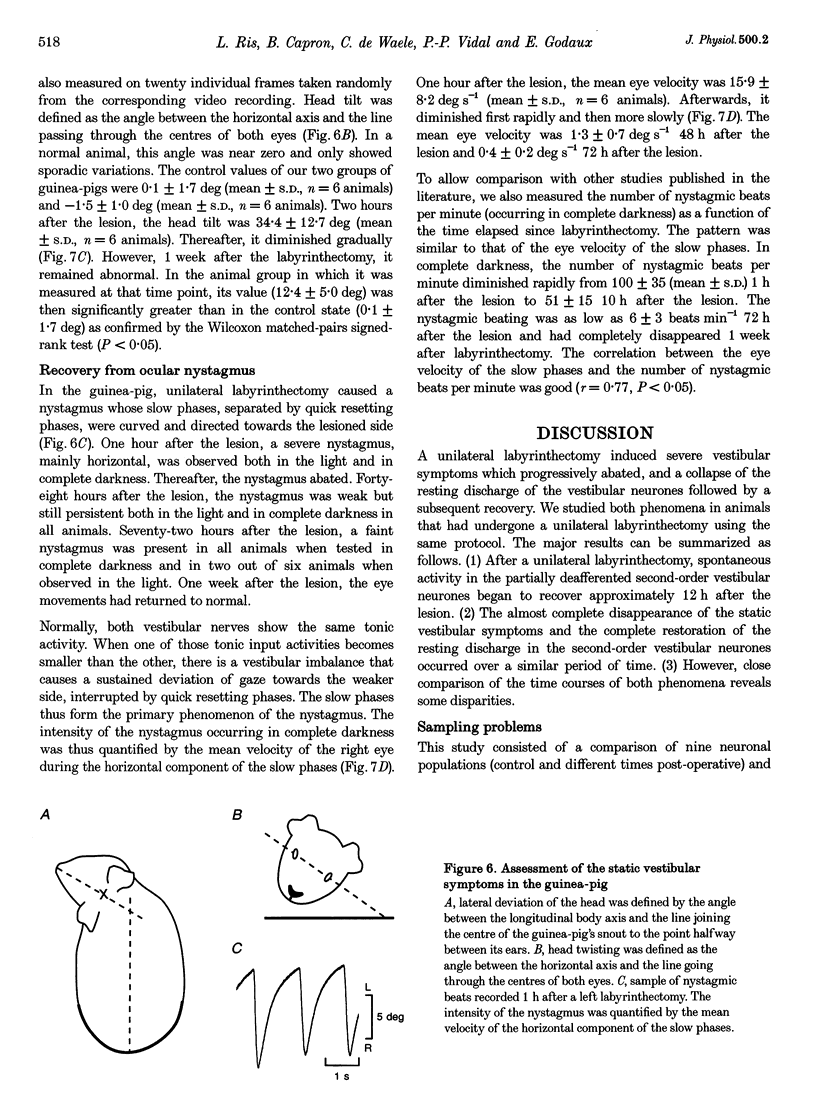
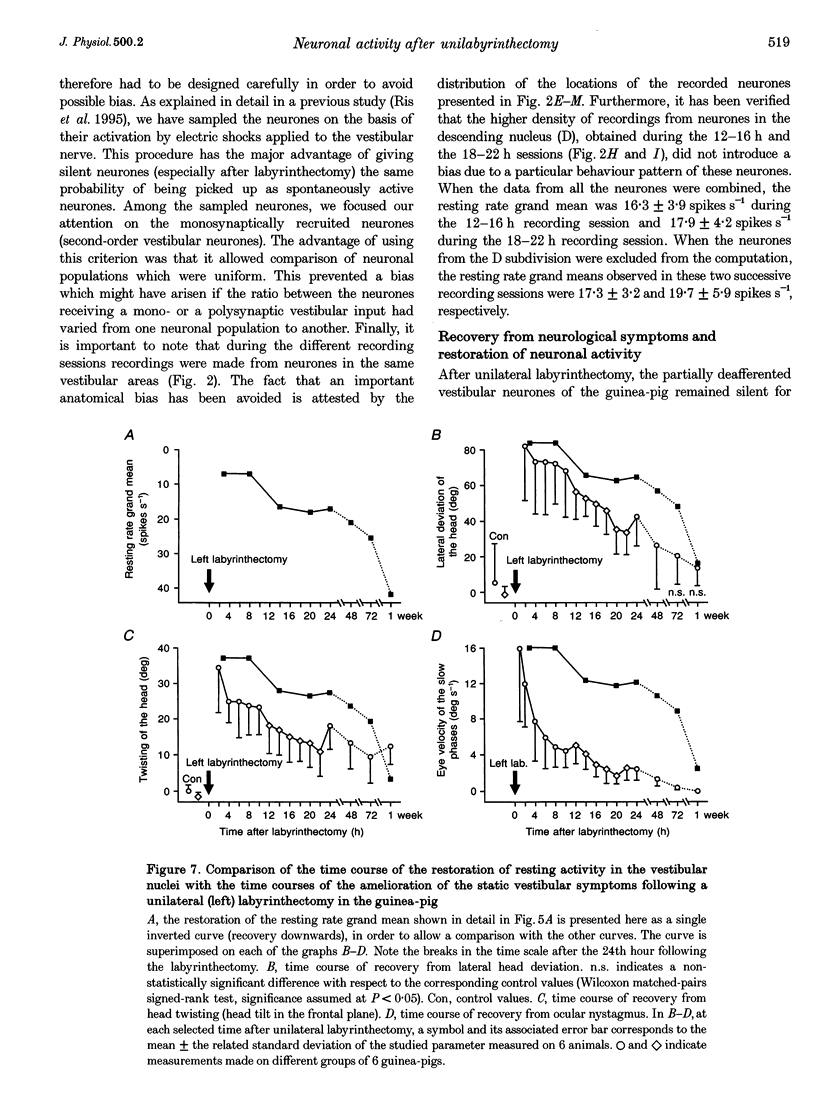
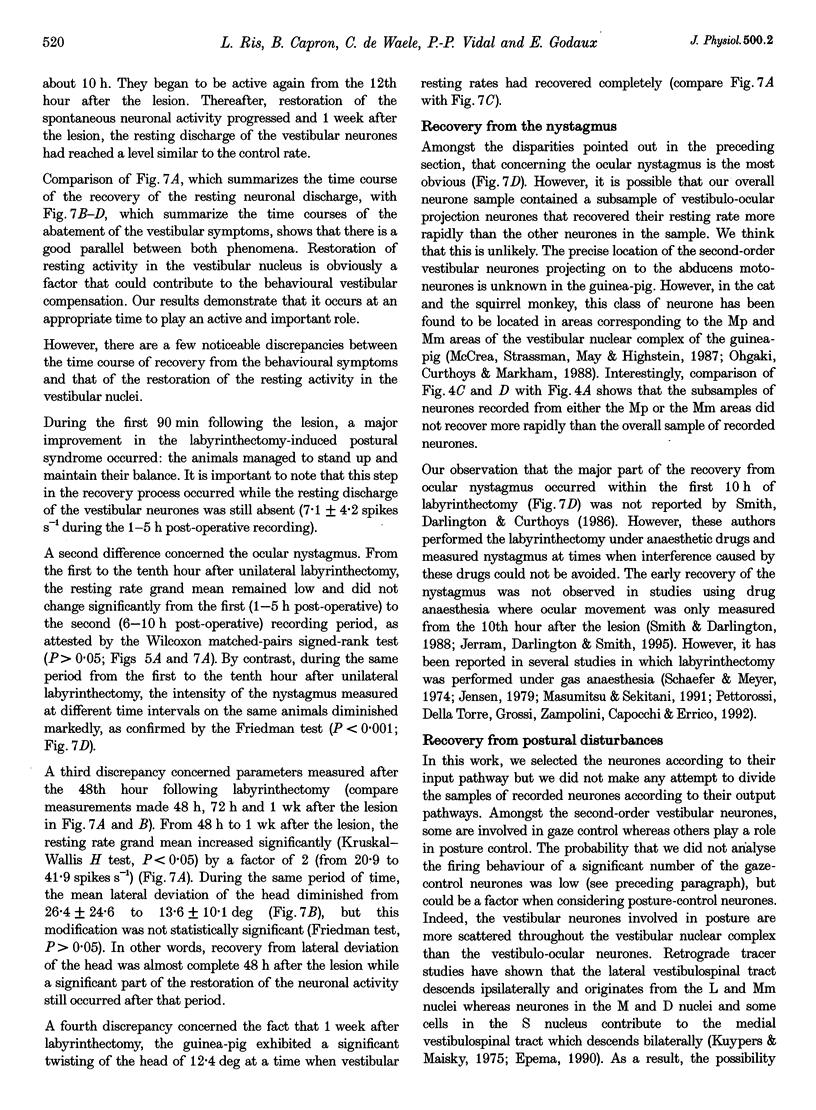
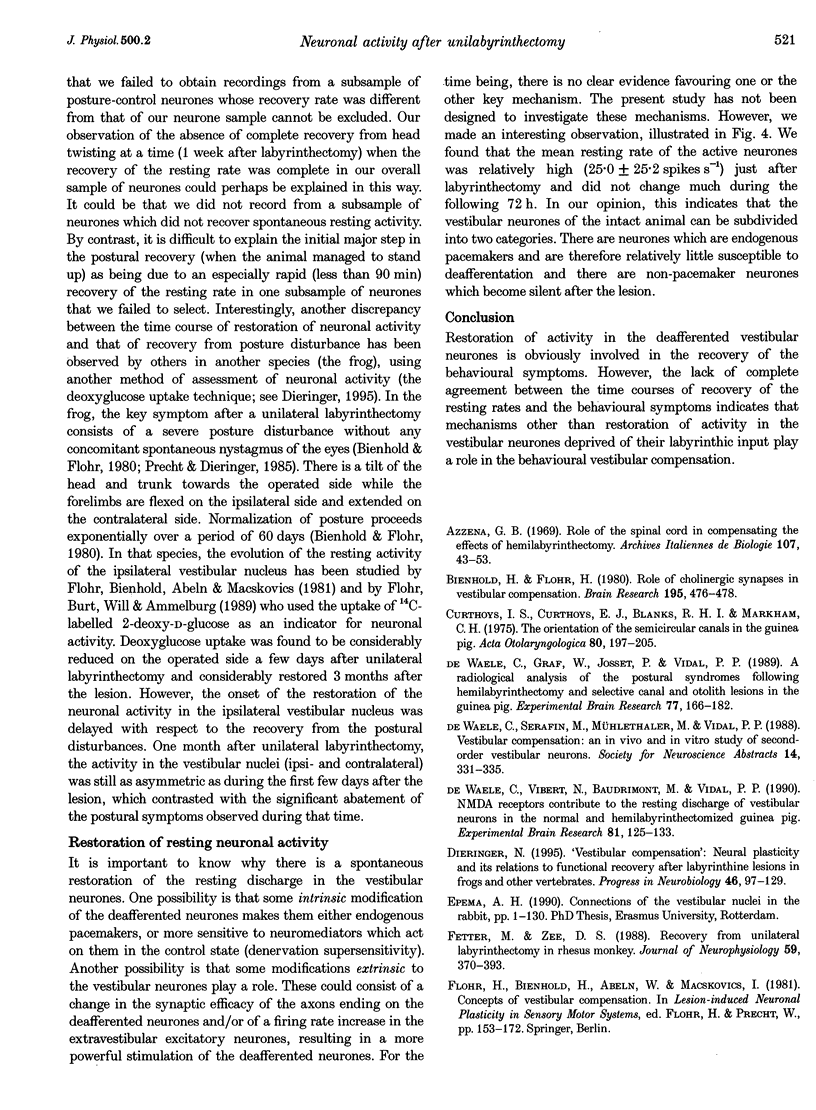
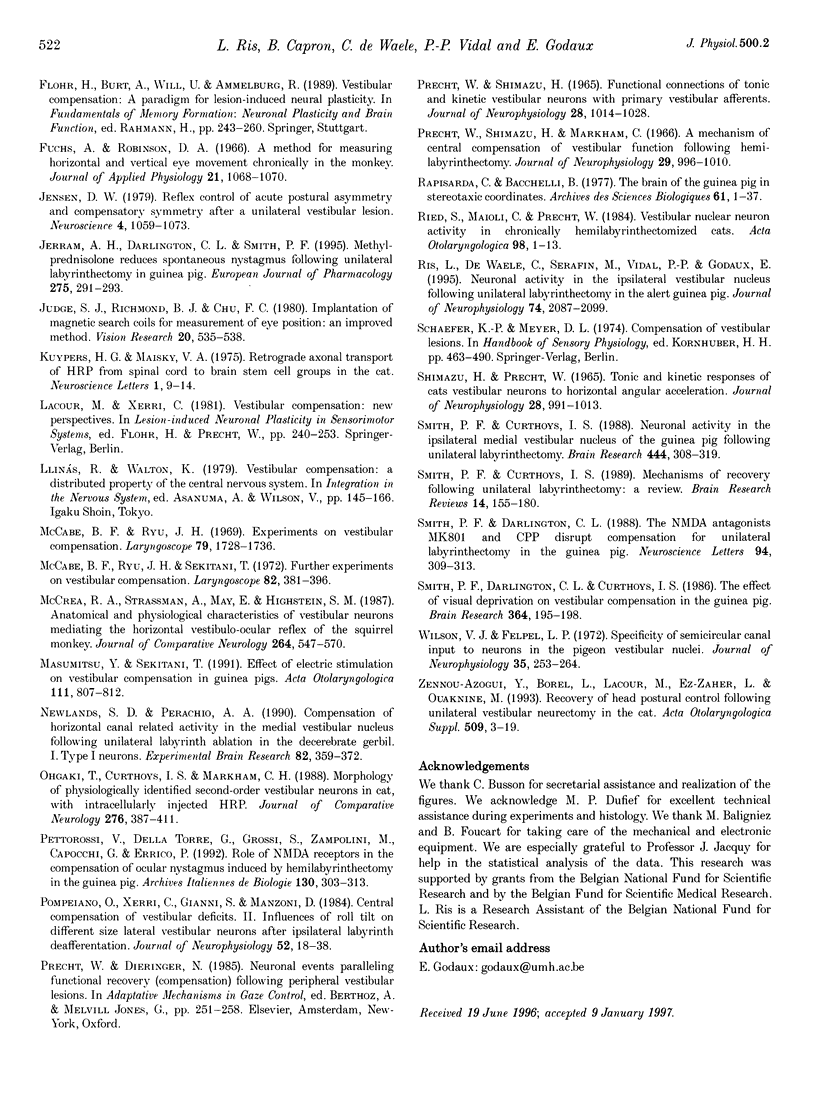
Selected References
These references are in PubMed. This may not be the complete list of references from this article.
- Azzena G. B. Role of the spinal cord in compensating the effects of hemilabyrinthectomy. Arch Ital Biol. 1969 Apr;107(1):43–53. [PubMed] [Google Scholar]
- Bienhold H., Flohr H. Role of cholinergic synapses in vestibular compensation. Brain Res. 1980 Aug 18;195(2):476–478. doi: 10.1016/0006-8993(80)90083-9. [DOI] [PubMed] [Google Scholar]
- Curthoys I. S., Curthoys E. J., Blanks R. H., Markham C. H. The orientation of the semicircular canals in the guinea pig. Acta Otolaryngol. 1975 Sep-Oct;80(3-4):197–205. doi: 10.3109/00016487509121319. [DOI] [PubMed] [Google Scholar]
- De Waele C., Graf W., Josset P., Vidal P. P. A radiological analysis of the postural syndromes following hemilabyrinthectomy and selective canal and otolith lesions in the guinea pig. Exp Brain Res. 1989;77(1):166–182. doi: 10.1007/BF00250579. [DOI] [PubMed] [Google Scholar]
- Dieringer N. 'Vestibular compensation': neural plasticity and its relations to functional recovery after labyrinthine lesions in frogs and other vertebrates. Prog Neurobiol. 1995 Jun;46(2-3):97–129. [PubMed] [Google Scholar]
- Fetter M., Zee D. S. Recovery from unilateral labyrinthectomy in rhesus monkey. J Neurophysiol. 1988 Feb;59(2):370–393. doi: 10.1152/jn.1988.59.2.370. [DOI] [PubMed] [Google Scholar]
- Fuchs A. F., Robinson D. A. A method for measuring horizontal and vertical eye movement chronically in the monkey. J Appl Physiol. 1966 May;21(3):1068–1070. doi: 10.1152/jappl.1966.21.3.1068. [DOI] [PubMed] [Google Scholar]
- Jerram A. H., Darlington C. L., Smith P. F. Methylprednisolone reduces spontaneous nystagmus following unilateral labyrinthectomy in guinea pig. Eur J Pharmacol. 1995 Mar 14;275(3):291–293. doi: 10.1016/0014-2999(95)00039-n. [DOI] [PubMed] [Google Scholar]
- Judge S. J., Richmond B. J., Chu F. C. Implantation of magnetic search coils for measurement of eye position: an improved method. Vision Res. 1980;20(6):535–538. doi: 10.1016/0042-6989(80)90128-5. [DOI] [PubMed] [Google Scholar]
- Masumitsu Y., Sekitani T. Effect of electric stimulation on vestibular compensation in guinea pigs. Acta Otolaryngol. 1991;111(5):807–812. doi: 10.3109/00016489109138415. [DOI] [PubMed] [Google Scholar]
- McCabe B. F., Ryu J. H. Experiments on vestibular compensation. Laryngoscope. 1969 Oct;79(10):1728–1736. doi: 10.1288/00005537-196910000-00004. [DOI] [PubMed] [Google Scholar]
- McCabe B. F., Ryu J. H., Sekitani T. Further experiments on vestibular compensation. Laryngoscope. 1972 Mar;82(3):381–396. doi: 10.1288/00005537-197203000-00005. [DOI] [PubMed] [Google Scholar]
- McCrea R. A., Strassman A., May E., Highstein S. M. Anatomical and physiological characteristics of vestibular neurons mediating the horizontal vestibulo-ocular reflex of the squirrel monkey. J Comp Neurol. 1987 Oct 22;264(4):547–570. doi: 10.1002/cne.902640408. [DOI] [PubMed] [Google Scholar]
- Newlands S. D., Perachio A. A. Compensation of horizontal canal related activity in the medial vestibular nucleus following unilateral labyrinth ablation in the decerebrate gerbil. I. Type I neurons. Exp Brain Res. 1990;82(2):359–372. doi: 10.1007/BF00231255. [DOI] [PubMed] [Google Scholar]
- Ohgaki T., Curthoys I. S., Markham C. H. Morphology of physiologically identified second-order vestibular neurons in cat, with intracellularly injected HRP. J Comp Neurol. 1988 Oct 15;276(3):387–411. doi: 10.1002/cne.902760305. [DOI] [PubMed] [Google Scholar]
- Pettorossi V. E., Della Torre G., Grassi S., Zampolini M., Capocchi G., Errico P. Role of NMDA receptors in the compensation of ocular nystagmus induced by hemilabyrinthectomy in the guinea pig. Arch Ital Biol. 1992 Oct;130(4):303–313. [PubMed] [Google Scholar]
- Pompeiano O., Xerri C., Gianni S., Manzoni D. Central compensation of vestibular deficits. II. Influences of roll tilt on different-size lateral vestibular neurons after ipsilateral labyrinth deafferentation. J Neurophysiol. 1984 Jul;52(1):18–38. doi: 10.1152/jn.1984.52.1.18. [DOI] [PubMed] [Google Scholar]
- Precht W., Dieringer N. Neuronal events paralleling functional recovery (compensation) following peripheral vestibular lesions. Rev Oculomot Res. 1985;1:251–268. [PubMed] [Google Scholar]
- Precht W., Shimazu H., Markham C. H. A mechanism of central compensation of vestibular function following hemilabyrinthectomy. J Neurophysiol. 1966 Nov;29(6):996–1010. doi: 10.1152/jn.1966.29.6.996. [DOI] [PubMed] [Google Scholar]
- Rapisarda C., Bacchelli B. The brain of the guinea pig in stereotaxic coordinates. Arch Sci Biol (Bologna) 1977 Jan-Dec;61(1-4):1–37. [PubMed] [Google Scholar]
- Ried S., Maioli C., Precht W. Vestibular nuclear neuron activity in chronically hemilabyrinthectomized cats. Acta Otolaryngol. 1984 Jul-Aug;98(1-2):1–13. doi: 10.3109/00016488409107529. [DOI] [PubMed] [Google Scholar]
- Ris L., de Waele C., Serafin M., Vidal P. P., Godaux E. Neuronal activity in the ipsilateral vestibular nucleus following unilateral labyrinthectomy in the alert guinea pig. J Neurophysiol. 1995 Nov;74(5):2087–2099. doi: 10.1152/jn.1995.74.5.2087. [DOI] [PubMed] [Google Scholar]
- Shimazu H., Precht W. Tonic and kinetic responses of cat's vestibular neurons to horizontal angular acceleration. J Neurophysiol. 1965 Nov;28(6):991–1013. doi: 10.1152/jn.1965.28.6.991. [DOI] [PubMed] [Google Scholar]
- Smith P. F., Curthoys I. S. Mechanisms of recovery following unilateral labyrinthectomy: a review. Brain Res Brain Res Rev. 1989 Apr-Jun;14(2):155–180. doi: 10.1016/0165-0173(89)90013-1. [DOI] [PubMed] [Google Scholar]
- Smith P. F., Curthoys I. S. Neuronal activity in the ipsilateral medial vestibular nucleus of the guinea pig following unilateral labyrinthectomy. Brain Res. 1988 Mar 22;444(2):308–319. doi: 10.1016/0006-8993(88)90939-0. [DOI] [PubMed] [Google Scholar]
- Smith P. F., Darlington C. L., Curthoys I. S. The effect of visual deprivation on vestibular compensation in the guinea pig. Brain Res. 1986 Jan 29;364(1):195–198. doi: 10.1016/0006-8993(86)91004-8. [DOI] [PubMed] [Google Scholar]
- Smith P. F., Darlington C. L. The NMDA antagonists MK801 and CPP disrupt compensation for unilateral labyrinthectomy in the guinea pig. Neurosci Lett. 1988 Dec 5;94(3):309–313. doi: 10.1016/0304-3940(88)90036-5. [DOI] [PubMed] [Google Scholar]
- Wilson V. J., Felpel L. P. Specificity of semicircular canal input to neurons in the pigeon vestibular nuclei. J Neurophysiol. 1972 Mar;35(2):253–264. doi: 10.1152/jn.1972.35.2.253. [DOI] [PubMed] [Google Scholar]
- Zennou-Azogui Y., Borel L., Lacour M., Ez-Zaher L., Ouaknine M. Recovery of head postural control following unilateral vestibular neurectomy in the cat. Neck muscle activity and neuronal correlates in Deiters' nuclei. Acta Otolaryngol Suppl. 1993;509:1–19. [PubMed] [Google Scholar]
- de Waele C., Vibert N., Baudrimont M., Vidal P. P. NMDA receptors contribute to the resting discharge of vestibular neurons in the normal and hemilabyrinthectomized guinea pig. Exp Brain Res. 1990;81(1):125–133. doi: 10.1007/BF00230108. [DOI] [PubMed] [Google Scholar]


